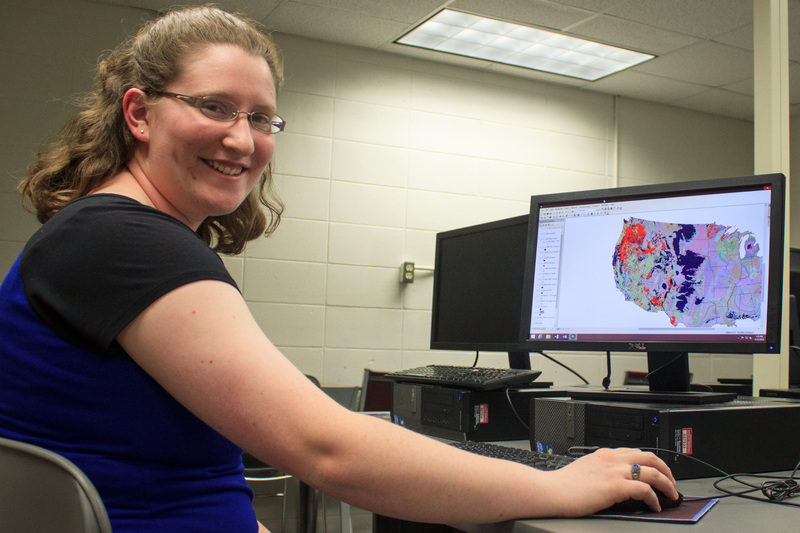VanDerslice accepts internship with NASA

Chadron State College junior, Joslynn VanDerslice has accepted a NASA internship working with the Mars 2020 mission.
<p class="Paragraph SCX81694006" segoe="" ui",tahoma,verdana,"sans-serif";="" background-color:="" transparent;="" color:="" windowtext;="" text-align:="" left;="" text-indent:="" 0px;="" margin-right:="" font-size:="" 6pt;"="" style="box-sizing: border-box; margin: 0px 0px 10px; font-weight: normal; font-style: normal; vertical-align: baseline;">Starting in June, VanDerslice of Columbus, Nebraska, will participate in a 10-week-long internship at the Jet Propulsion Laboratory located in La Cañada Flintridge, California.
<p class="Paragraph SCX81694006" segoe="" ui",tahoma,verdana,"sans-serif";="" background-color:="" transparent;="" color:="" windowtext;="" text-align:="" left;="" text-indent:="" 0px;="" margin-right:="" font-size:="" 6pt;"="" style="box-sizing: border-box; margin: 0px 0px 10px; font-weight: normal; font-style: normal; vertical-align: baseline;">“I’ll be looking for earth rocks that are similar to Mars rocks,” VanDerslice said. These rocks will be used to test equipment for the Mars 2020 Mission, named after the year of the intended launch according to VanDerslice.
<p class="Paragraph SCX81694006" segoe="" ui",tahoma,verdana,"sans-serif";="" background-color:="" transparent;="" color:="" windowtext;="" text-align:="" left;="" text-indent:="" 0px;="" margin-right:="" font-size:="" 6pt;"="" style="box-sizing: border-box; margin: 0px 0px 10px; font-weight: normal; font-style: normal; vertical-align: baseline;">Chadron State Physical and Life Sciences professor Michael Leite said VanDerslice’s work will be crucial to the Mars 2020 Mission.<p class="Paragraph SCX81694006" segoe="" ui",tahoma,verdana,"sans-serif";="" background-color:="" transparent;="" color:="" windowtext;="" text-align:="" left;="" text-indent:="" 0px;="" margin-right:="" font-size:="" 6pt;"="" style="box-sizing: border-box; margin: 0px 0px 10px; font-weight: normal; font-style: normal; vertical-align: baseline;">“There is a big need to make these tools as strong and light as possible because of the huge risks associated with sending them to another planet and being unable to fix them if they break,” Leite said.
<p class="Paragraph SCX81694006" segoe="" ui",tahoma,verdana,"sans-serif";="" background-color:="" transparent;="" color:="" windowtext;="" text-align:="" left;="" text-indent:="" 0px;="" margin-right:="" font-size:="" 6pt;"="" style="box-sizing: border-box; margin: 0px 0px 10px; font-weight: normal; font-style: normal; vertical-align: baseline;">In the fall of 2014, some of Leite’s students, including VanDerslice, traveled to Wyoming for a rocks and mineral class where they were looking for rocks that might be similar to those found on Mars. Greg Peters, online CSC student from California, who works for the NASA Jet Propulsion Laboratory, collaborated on this field trip and suggested the internship to VanDerslice.
<p class="Paragraph SCX81694006" segoe="" ui",tahoma,verdana,"sans-serif";="" background-color:="" transparent;="" color:="" windowtext;="" text-align:="" left;="" text-indent:="" 0px;="" margin-right:="" font-size:="" 6pt;"="" style="box-sizing: border-box; margin: 0px 0px 10px; font-weight: normal; font-style: normal; vertical-align: baseline;">“It still doesn’t feel real,” said VanDerslice.
<p class="Paragraph SCX81694006" segoe="" ui",tahoma,verdana,"sans-serif";="" background-color:="" transparent;="" color:="" windowtext;="" text-align:="" left;="" text-indent:="" 0px;="" margin-right:="" font-size:="" 6pt;"="" style="box-sizing: border-box; margin: 0px 0px 10px; font-weight: normal; font-style: normal; vertical-align: baseline;">VanDerslice is majoring in geoscience with a minor in Water Resources Management. Her research on Mars-like rocks will also be applied to her capstone research and thesis. VanDerslice has already begun her research on intersecting areas that contain sandstone and basalt.
<p class="Paragraph SCX81694006" segoe="" ui",tahoma,verdana,"sans-serif";="" background-color:="" transparent;="" color:="" windowtext;="" text-align:="" left;="" text-indent:="" 0px;="" margin-right:="" font-size:="" 6pt;"="" style="box-sizing: border-box; margin: 0px 0px 10px; font-weight: normal; font-style: normal; vertical-align: baseline;">According to her job description during her internship she will be researching for terrestrial geological context and providing updates to the Geo Analogs database, assisting with testing to determine the physical properties of Mars analogs under Martian conditions and assisting in the development of geological test articles for use in Mars Environment testing.
<p class="Paragraph SCX81694006" segoe="" ui",tahoma,verdana,"sans-serif";="" background-color:="" transparent;="" color:="" windowtext;="" text-align:="" left;="" text-indent:="" 0px;="" margin-right:="" font-size:="" 6pt;"="" style="box-sizing: border-box; margin: 0px 0px 10px; font-weight: normal; font-style: normal; vertical-align: baseline;">VanDerslice developed her interest for geoscience in the seventh grade when she took part in project testing waters through her science class. Last summer, she had an internship working with the city of Columbus as a laboratory technician for the Columbus Wastewater Treatment Facility.
—Miranda Wieczorek, College Relations Student Liaison
Category: Campus News
